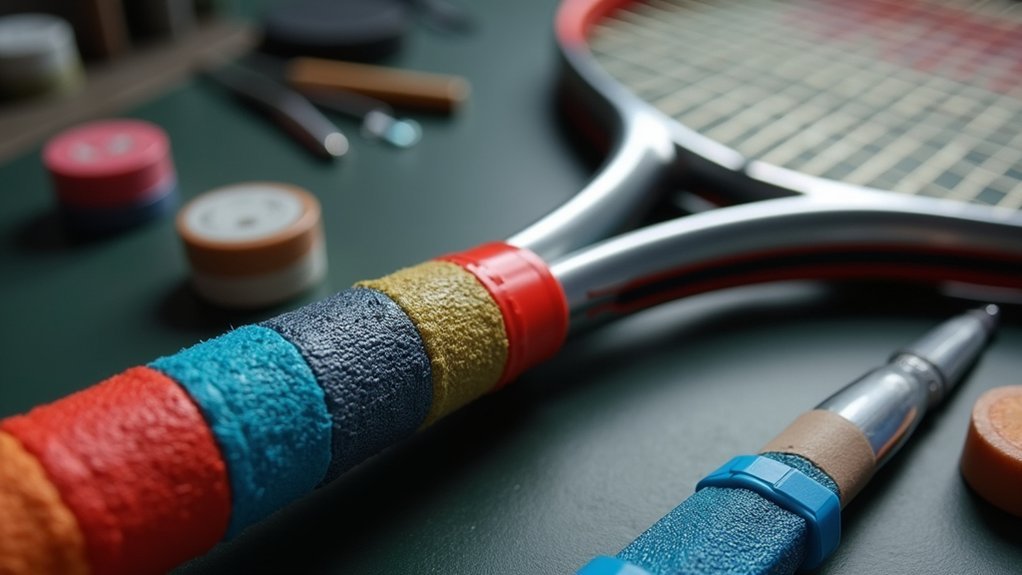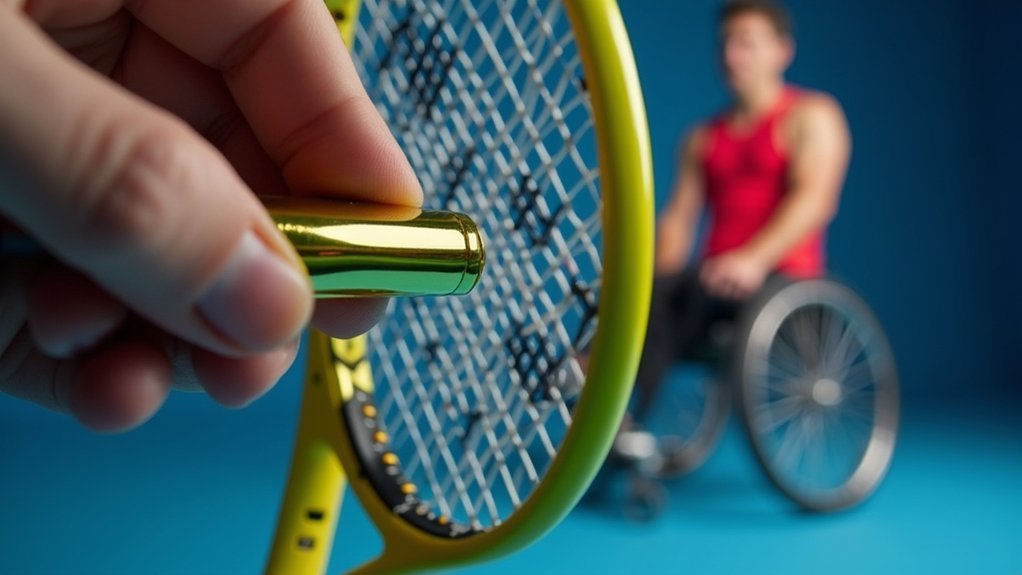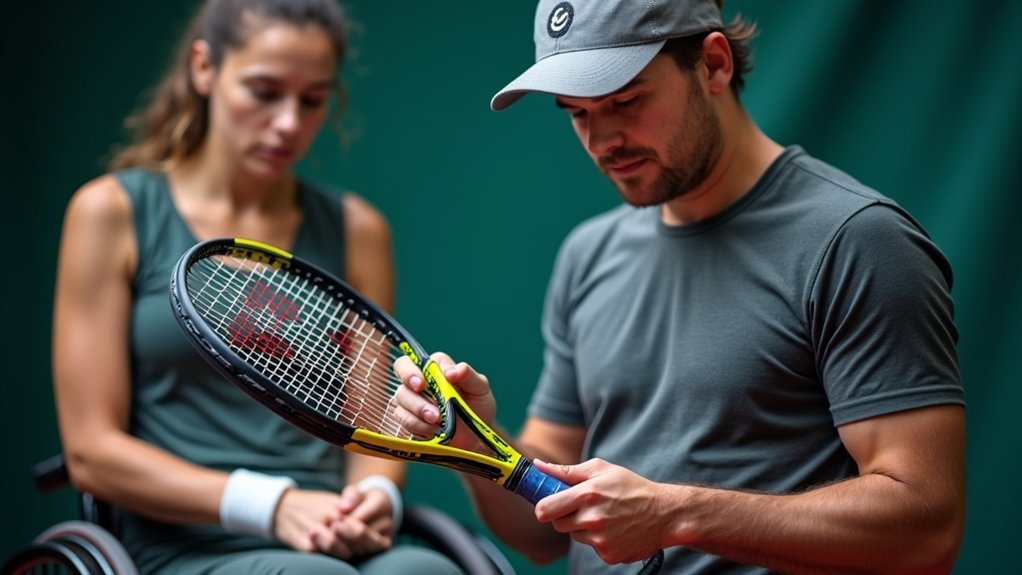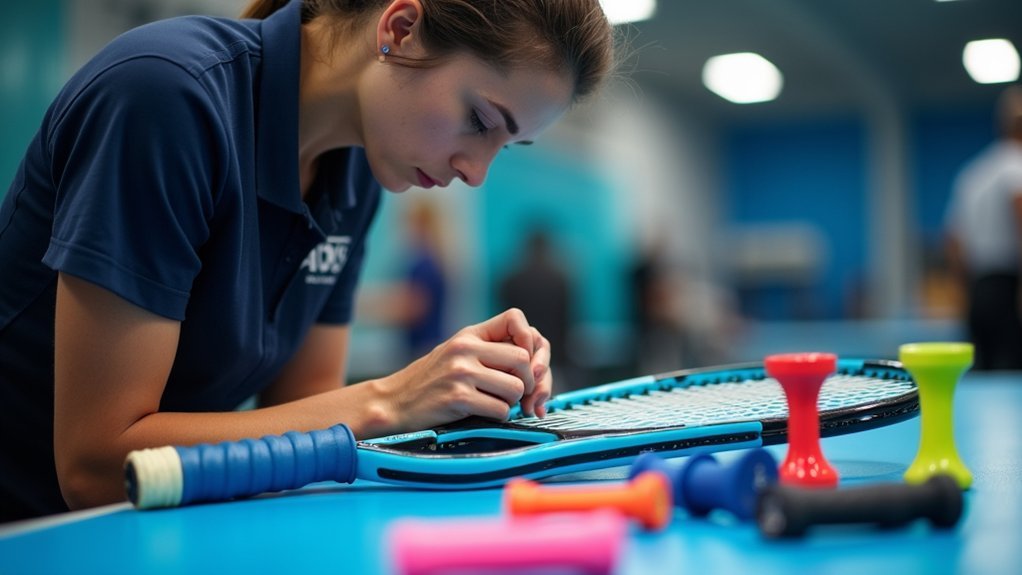Customizing your tennis racket for wheelchair play is essential for peak performance. Focus on grip modifications with softer materials and textured surfaces to enhance control. Adjust weight distribution for better maneuverability—lighter frames reduce fatigue while head-heavy options provide power. Consider lower string tensions (22-24 kg) for power or higher (25-27 kg) for control. Don’t overlook frame customization and specialized accessories that complement your seated position. These adaptations can transform your game completely.
Grip Modifications for Enhanced Control and Comfort

Nearly every wheelchair tennis player can benefit from customized grip modifications that transform standard rackets into personalized performance tools.
When you’re competing from a seated position, your grip becomes even more critical for maintaining control and executing powerful strokes.
Customized grip sizes prevent slippage and provide comfort during extended play.
You’ll find that adding softer materials helps with shock absorption and reduces unwanted vibrations, particularly beneficial if you have limited hand strength.
Consider textured surfaces or specialized grip tapes to enhance traction during intense rallies.
Ergonomic designs accommodate your unique hand shape, promoting a natural wrist position that prevents injuries.
Weight and Balance Adjustments for Wheelchair Maneuverability
Weight and balance adjustments represent another dimension of racket customization beyond grip modifications.
When customizing your equipment, consider how weight distribution affects your maneuverability on court. Lighter racket frames, particularly those made from titanium alloy or advanced composites, can reduce arm fatigue while improving your response time during play.
The balance point of your racket notably impacts your performance as a wheelchair athlete. Head-heavy rackets provide more power, while head-light options enhance maneuverability and quick reactions.
Balance is crucial for wheelchair players—head-heavy rackets deliver power, while head-light designs offer the quick mobility you need on court.
You’ll want to find the sweet spot that complements your playing style while maintaining stability during serves and returns.
Remember that these adjustments work in concert with appropriate grip sizes and string types to optimize your racket performance. The right combination of these elements can transform your game through personalized customization.
String Tension Considerations for Adaptive Play

While grip modifications and weight distribution form the foundation of your customized setup, string tension represents perhaps the most nuanced adjustment for wheelchair athletes.
Finding the ideal string tension can dramatically transform your adaptive play experience.
If you’re developing your skills or have limited upper body strength, consider lower string tensions between 22-24 kg. This range provides enhanced power and a softer feel, allowing you to make effective shots with less physical effort.
Conversely, if you’ve developed consistent technique, higher string tensions of 25-27 kg offer superior control and spin potential.
Your playing style should ultimately guide this decision.
Remember that string tension isn’t a static setting—schedule regular performance adjustments as your game evolves. The perfect tension balances your physical capabilities with your tactical approach to wheelchair tennis.
Frame Customization for Seated Position Advantages
Because wheelchair athletes compete from a seated position, frame customization becomes essential for optimizing racket performance.
Frame customization isn’t just helpful—it’s essential for wheelchair athletes seeking to optimize their racket’s performance from a seated position.
You’ll find that adjusting grip size and angle greatly improves your control and comfort while playing. Custom frame materials like lightweight titanium alloys enhance maneuverability, helping you avoid fatigue during longer matches.
- A lower frame height allows you to access balls more easily from your wheelchair, resulting in cleaner strikes and improved shot accuracy.
- Larger head sizes provide an expanded sweet spot, making consistent ball contact achievable despite limited mobility.
- Ergonomic shapes contoured specifically for seated players transform your racket into a natural extension of your arm.
- Textured surfaces on grips prevent slippage during aggressive play, maintaining your stroke integrity throughout matches.
Specialized Accessories for Wheelchair Tennis Performance

Since mastering wheelchair tennis requires both skill and proper equipment, specialized accessories can dramatically improve your on-court performance.
Hand rim covers enhance your grip and control, allowing you to maneuver more effectively during matches. You’ll benefit from padded ratchet straps that provide waist security, keeping you firmly seated while focusing on your game.
For ideal stability, consider adding thigh, calf, and foot straps that maintain proper positioning during play.
Don’t overlook safety features like anti-tip caster wheels that prevent tipping during aggressive movements.
The best performance comes from customization—adjust your seat depth, footrest height, and center of gravity to match your unique needs.
These accessories work together to create a wheelchair setup that supports your playing style and maximizes your potential on the court.
Frequently Asked Questions
What Is the One Modified Rule for Wheelchair Tennis That Differs From Standard Tennis?
You’re allowed two bounces instead of one in wheelchair tennis. The first bounce must be in court, but the second can be outside the lines, giving you more time to position yourself.
How Can I Customize My Tennis Racket?
You can customize your racket by selecting grip size, string tension, and frame weight. You’ll also choose string materials, frame composition, and head size to match your playing style and preferences.
How Many Sets for Wheelchair Tennis?
You’ll play the best of three sets in wheelchair tennis. You need to win two sets to win the match. Sets follow standard tennis rules with games to six and potential tiebreakers at 6-6.
Can Able Bodied People Compete in Wheelchair Tennis?
Yes, you can compete in wheelchair tennis as an able-bodied person. You’ll need to use a regulation wheelchair during matches and follow the same rules, including the two-bounce allowance for returns.





Leave a Reply